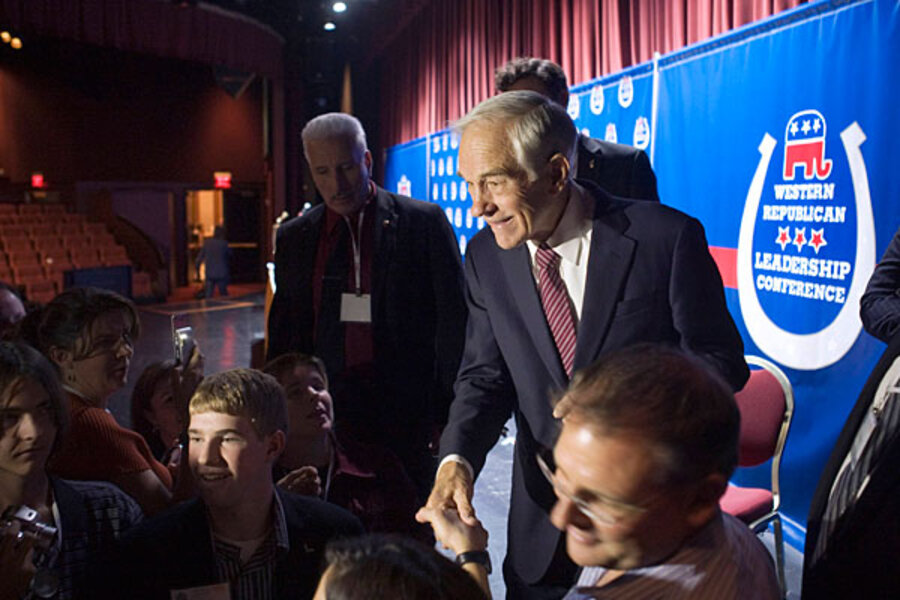Ron Paul ad blitz: Will it work?
Loading...
Ron Paul is launching a multimillion-dollar ad blitz in early voting states, in case you haven’t heard. That makes him pretty much the first candidate to take to the airwaves in a major way with the intent of shaping the initial contours of the Republican presidential race.
Will that strategy work for him?
Before we address that question directly, let’s take a look at the ads themselves. They’re textbook middle-of-the-road political advertising. By that, we don’t mean the content is middle-of-the-road: Mr. Paul’s libertarianism is of a pure variety and not every voter’s cup of hot beverage. But the ads themselves are well-produced in a usual way, without the transcendent weirdness of Carly Fiorina’s “Demon Sheep” ad or Christine O’Donnell’s classic spot, “I Am Not a Witch.”
The leadoff ad, “Plan,” introduces Paul’s new budget-balancing outline to voters. It visually highlights that he’s proposing to cut $1 trillion, eliminate five federal bureaucracies, end foreign wars, and rein in the Federal Reserve in Year 1 of a President Paul administration.
(It doesn’t say anything about things such as: Who’d be taking care of the national parks after the Paul team does away with the Department of the Interior? But hey, details to come, right?)
The second ad, in its conception, may be more interesting. It’s a negative ad that attacks Mitt Romney, Rick Perry, and Herman Cain from the right.
It depicts Barack Obama’s economic efforts as a failure, then says that Messrs. Romney, Perry, and Cain all at some point expressed support for bailing out US banks and/or economic stimulus programs.
“Where are the people who will say all of this stuff is socialism?” intones the Paul ad.
We know where! In the last section of the ad, where a smiling Paul says that “now we’re bankrupt, and we have to decide which way to go.”
Look, Paul is still the longest of long shots to win the nomination. He’s running at around 8 percent of the vote in national polls. His noninterventionist brand of foreign policy does not mesh with the views of most Republican voters. His staunch libertarianism can seem chilly to the party’s remaining moderates. The oddsmakers at the Intrade prediction market say he’s got only a 2.4 chance of emerging from the GOP primaries victorious.
That said, it’s possible these ads could have a major effect on Paul’s standing within the race and his subsequent national image and popularity.
One reason why this might be so is he’s got lots of money to run the spots. He’s raised over $12 million in this election cycle, behind only Romney and Perry. Cain, for example, probably does not have the resources to put up such a series of ads this early.
Plus, the spots are targeted at early-voting states, such as Iowa and New Hampshire – and in Iowa, at least, it is possible to envision a Paul breakout scenario in which he does well.
Paul’s polls in Iowa run ahead of his national numbers – right now he’s getting about 10.5 percent of the Hawkeye State vote, according to the RealClearPolitics rolling average of major surveys. That puts him third, behind Cain and Romney – but ahead of Perry.
Plus, Michele Bachmann, who’s right behind Paul at 9.5 percent of the Iowa vote, may be imploding. Her New Hampshire staff has quit, her fundraising is drying up, and she isn’t standing out in the debates. It’s possible that her supporters, who tend to be staunch fiscal conservatives, could begin drifting to “I’ll cut $1 trillion right away” Ron Paul.
If Cain or Romney commit some slip – and in this up-and-down political year, there have been candidate slips aplenty – Paul could sneak into second. A silver medal in Iowa would put Paul in headlines and boost him heading toward New Hampshire.
Of course, it’s also possible this is a lot of sound and fury signifying ignorance. Maybe campaign ads make very little difference at all – an idea they’re exploring on The New York Times FiveThirtyEight polling blog.
But that’s a post for another day.





